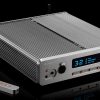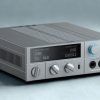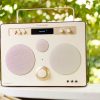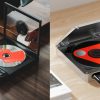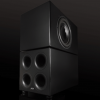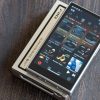The are a lot of audio specifications that can be confusing for the mainstream consumer. No single specification provides a full picture as to how well an audio product will perform, but one that is important is the Signal-to-noise ratio (aka S/N or SNR).
Why Signal-to-Noise Ratio Is Important
The Signal-to-Noise ratio is a measurement that represents the comparison of audio signal strength to the base level of noise (aka noise floor) in a specific device or audio system.
The Signal-to-Noise ratio is stated in Decibels. As the decibel number increases, it means that the audio content becomes less affected by unwanted noise through your audio components and related sources. Likewise, as the decibel number stated decreases, it means the degree of noise increases.

When looking at audio specs for components such as stereo/av receivers, amplifiers, CD players, and turntables, check the signal-to-noise ratio.
Tip: Fortunately, since almost all audio components list their Signal-to-Noise Ratio (S/N, SNR) in product specifications, you don’t have to try to calculate it yourself.
When an audio component lists a signal-to-noise ratio of 100 dB, it means that the audio signal level is 100 dB higher than the noise level. Therefore, a signal-to-noise ratio specification of 100 dB is considerably better than one that is 50 dB or less.
Tip: CDs typically have an S/N ratio of 90dB or greater and vinyl records typically top out with an S/N ratio of 65dB.
Audio components that provide signal-to-noise ratio specifications include:
- Headphones
- Microphones
- Amplifiers
- Stereo/AV Receivers
- Powered Speakers
- Powered Subwoofers
- Turntables
- Audio Cassette Decks
- CD/DVD/Blu-ray/UHD Blu-ray players
- Radios (AM, FM, Shortwave)
- Network Music Streamers
- Bluetooth and Wireless Speakers
- PC sound cards
- Smartphones
Vinyl Records
What is interesting when comparing S/N between CDs (90dB) and Vinyl Records (65db) is that many music listeners prefer listening to Vinyl Records to CDs. In some ways, it can be said that the noise present in vinyl records (which includes noise present in the recording as well as disc surface noise introduced through the phono cartridge and stylus) is a good thing, as it adds “warmth” to the final recording, as opposed to CDs where the noise level is so low that the sound you hear is too sterile. In this case, the lack of any perceptible noise is not necessarily a good thing. Of course, the CD vs Vinyl (aka Analog vs Digital) sound quality debates seems to be never-ending.
Wi-Fi
S/N ratio is also important for Wi-Fi. If you have your Wi-Fi with an S/N of 40dB that is definitely more desirable than an S/N of only 20dB.
If you have a Wi-Fi signal with too much noise in relation to the intended signal, your Wi-Fi network will be compromised. The reason for this is that your Wi-Fi-connected devices will have more difficulty detecting a usable signal over un-usable noise.
Radio
Noise is also a factor in radio transmission and is especially present with AM and Shortwave reception. The noise can be the result of a weak signal due to transmission distance, and/or interference from electric motors, fluorescent lights, and other sources of electrical interference. This means that the higher the S/N ratio the AM or Shortwave radio has, the less susceptible it is to the sources of noise.
Detecting and Identifying Noise
One way to find out if your components have noise, turn the volume up when nothing is playing. If you hear noise, such as a hiss or hum, that is the noise you are looking for, but don’t want.
Noise might take the form of white noise, electronic hiss, static, or a low or vibrating hum.
If you have a home theater setup, a powered subwoofer is one component to check for hum. Also, for those of us that listened to music on audio cassettes, tape hiss was definitely the enemy of music listening.
However, as long as the incoming signal is dominant and well above the noise floor, the audio will maintain a higher quality, which is the kind of signal-to-noise ratio preferred for a clear and accurate sound.
If you hear noise when listening to music, or watching a show or movie (and noise is not recorded on the content), raising the volume will not only increase what you want to hear but the noise level also.
Tip: If noise is actually recorded on content, for example, noise is present in the microphone or in the devices used to mix the audio, then it becomes a part of the audio signal and is no longer noise (in the way it is referred to in this article). It’s very difficult to remove noise if it ends up being recorded with the content. Couple that with any additional noise that is introduced by playback devices, and the noise problem becomes more magnified.
Components, wires, and cables, all noise to an audio signal at some level. Makers of high-end components design their products to keep the noise level as low as possible. It is more of a challenge to decrease noise in analog amplifiers and turntables, resulting in a lower signal-to-noise ratio than it is for digital devices.
Ways to Reduce Noise
When shopping for audio devices, check the specifications posted on the device’s official online product page and located the specification that is stated for the Signal-to-Noise ratio.
Since powerlines can introduce noise to audio systems and powered subwoofers, consider a decided line for your audio components.
Other options to consider that may be helpful include a direct connection to wall outlets (instead of power strips) or a power conditioner that also protects against voltage spikes. It also helps if all the outlets are fed with copper wiring (instead of aluminum), and if you do need to use an extension, make sure it has a heavy-duty construction with copper on both the plug and receptacle ends.
In addition, for inter-device audio connectivity, use shielded RCA cables if preferable.
By incorporating one or more of the above options, you may be able to unwanted reduce unwanted noise caused by electrical or RF interference.
Of course, you may still have to cope with a noisy refrigerator, central heating, or air-conditioning system, but that is another story…
Tip: Noise and Distortion are not the same. Distortion is typically introduced by intentionally altering a signal. For example, turning the volume level too high so that speakers start to crackle or clip, or when a guitarist alters sound to achieve a coarse playback effect. Unlike noise, distortion can typically be minimized or eliminated through controls available to the user. This means you can have a good S/N ratio and still encounter distortion that will affect the quality of an audio signal.
Related Reading
Understanding Speaker Frequency Response



